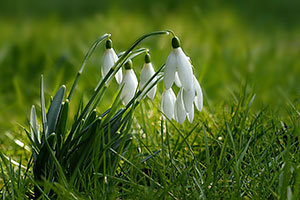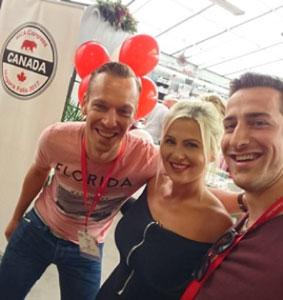Spring flowers are more than just some pretty blooms, they lift the heart and soul and are the promise of a lovely lazy summer, long warm days just around the corner and a lifting of the dreary winter gloom. All it takes are a few sunny yellow crocus in a pot or a whole host of daffodils underneath your shrubs and trees. A lot of spring flowers bloom underneath deciduous trees so are ideal for planting at the bottom of a deciduous hedge or underneath your shrubs. There is a whole range of plants to choose from, from tiny delicate pink Cyclamen coum to the heavenly scented Chimonanthus praecox (Wintersweet), a deciduous shrub with tiny pale lemon flowers which grows to a height of 4m (13’), best planted near a path where you can appreciate its aroma.
When we think of spring flowers the first images that come to mind are the bulbs, with drifts of snowdrops usually being the first to bloom closely followed by crocus.
They are available as dry bulbs in late summer, but you often have better success planting snowdrops ‘in the green’ in spring as the dry bulbs can have a high failure rate, depending upon where you buy them. A lot of the smaller flowering bulbs such as Chionodoxa (Glory of the Snow), Iris reticulata and histrioides, Fritillaria hermonis subsp. amana, Muscari (Grape Hyacinth) or Narcissus ‘Tete a tete’, look lovely in a rockery, an old Belfast sink or collection of terracotta pots.

Rhododendrons, azaleas and camellias are the staples of the spring garden giving you a glorious burst of colour, and occasionally fantastic scent. You will need an acid soil for these but if you do garden on alkaline soil you can grow some of the smaller varieties in large containers using ericaceous compost. The evergreen azaleas tend to be smaller than the deciduous but don’t have any scent; yakushimanum rhododendrons are also a smaller growing, evergreen species available in a variety of colours. For scent you can’t beat the deciduous Rhododendron luteum (Azalea pontica) which grows to about 180cm (6’) and is a lovely sunshine yellow.
An easy shrub for even the most inexperienced gardener is Forsythia x intermedia but it does really need a large garden as it gives a huge blast of yellow for a couple of weeks and then is quite boring for the rest of the year. Magnolia stellata with it’s lovely white starry flowers would suit a small to medium garden as it only reaches a height of about 3m (10’), the large flowered magnolias really need a large garden but are worth finding space for in a sheltered position, as their buds are very susceptible to frost damage. Pieris is largely grown for its fresh red and pink foliage in spring, but they do have some interest for the rest of the year. They also come in varying sizes, some being suitable for even the smallest garden, ‘Little Heath’ is very slow growing, has lovely cream and light green foliage, and is quite happy growing in a container.
You can soon perk up a bland patio, backyard or entrance with some instant colour in the form of bedding plants in a container, window trough or hanging basket. The most readily available are Primulas, Bellis perennis (Daisies), Myosotis sylvatica (Forget-me-nots), Violas and Pansies. Just add some small trailing ivies and a little conifer in the centre and you have a quick, not very expensive burst of colour.
Whatever the size of your garden there are spring flowers to suit every situation from huge rhododendrons to a little pot of daffodils or dwarf tulips on the windowsill. So no excuse for not bringing a little bit of cheerfulness into a grey spring day.
Written by: Angela Slater from Hayes Garden World



